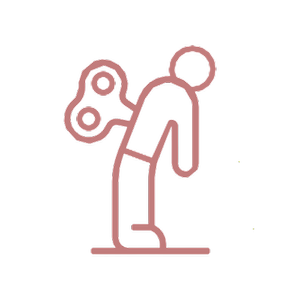Common Symptoms of Perimenopause
Menopause is a normal and natural transition stage of life that every individual with ovaries goes through.
The years leading up to menopause (called perimenopause) are a period of recalibration marked by significant physical, cognitive and psychological changes.
Despite this, many individuals report being unaware of the changes that occur, which can lead to a lack of support and even misdiagnosis of symptoms, and leave individuals without knowledge of or access to treatment and lifestyle support that can help.
Read on to find out more or download the free guide to read later.

What the Heck is Happening?
Perimenopause is the transition period between our reproductive years normally marked by regular menstrual cycles, and our post-menopausal years where menstrual cycles have ceased.
The timing and symptoms of menopause vary from person to person, with symptoms lasting between about 5 and 15 years, and for some, these can continue into post-menopause for a decade or more. Perimenopause can begin up to 10 years before the last menstrual period, which means the onset of symptoms can occur as early as your 30s.
Every individual’s experience of menopause is different, with some reporting breezing through with no symptoms at all, and others experiencing symptoms that have a significant negative impact on their lives (1).
In Australia, the average age of reaching menopause (the first day of your final menstrual period) is 51 to 52 years of age.

Is it Burnout or Is it Perimenopause?
It is not uncommon for perimenopause and other midlife stressors (like parenting teens or younger children, caring for relatives and increasing career responsibilities) to collide. Many of the symptoms of perimenopause overlap with the symptoms of chronic stress and even burnout (4), so it can be difficult to tease out the root cause of the symptoms.
A lot of individuals describe that they “just don’t feel like themselves any more” and attribute their symptoms to ongoing stress or burnout. This can be due to a lack of awareness of perimenopause and its potential symptoms, or the symptoms of both perimenopause and chronic stress overlapping.
The range of perimenopause symptoms varies greatly from individual to individual and can include the following.

Physical Concerns:
Menstrual Cycle Changes: Irregular periods (varying in cycle length, bleed duration, and flow heaviness).
Hot Flushes: Sudden feelings of warmth, often intense.
Night Sweats: Sweating excessively at night, potentially disrupting sleep.
Body and Joint Pain: Aches and pains not associated with activity or injury
Vulval and Vaginal Dryness: Decreased natural lubrication can lead to discomfort,
including during intimacy.
Fatigue: Persistent tiredness and a sense of exhaustion.
Sleep Issues: Problems with falling asleep & staying asleep.
Decreased Libido: Decreased desire or ability to enjoy sex.
Hair Loss: Including thinning, breakage or hair loss.
Headaches: Caused by fluctuating hormones.

Cognitive Concerns:
Forgetfulness: Memory lapses and an increase in forgetfulness.
Cognitive Difficulties: Experiences of 'brain fog' or trouble with concentration and finding the right words.
Stress Management:
Previously manageable stress may become overwhelming, and the ability to juggle multiple things can decrease.
Psychological Concerns:
Mood Changes: Fluctuations in emotional state, from
feeling content to experiencing unexplained sadness or irritability.
Mood Swings: Sudden and unexplained changes in mood.
Anxiety and Depression: Increased feelings of anxiousness or depressive episodes.
Loss of Motivation and Social Withdrawal: A decline in the desire to engage in activities or pursue interests previously enjoyed.
Identity Confusion: Questions about the role you play in personal and professional life may arise, particularly when paired with changes like empty nesting or divorce (6).
Loss of Confidence: Self-assurance may wane, leading to feelings of uncertainty. Shifting sense of values and purpose: A reevaluation of life's values and sense of purpose might occur.
Body Image: Changes in body shape and appearance can lead to a greater sense of dissatisfaction or self-consciousness, and previous issues with body image may resurface.
Although these are the most common, it is not an exhaustive list. Less commonly, symptoms can vary from itchy skin and burning tongue to breast pain & tenderness, bloating and other digestive problems and incontinence.

But, It’s NOT all bad news!
Perimenopause is a rite of passage. Just like puberty and the journey through pregnancy and postpartum, this stage of recalibration has a powerful purpose. It’s a natural part of the life cycle where we are invited to call into focus our lives, ask some big questions, and get crystal clear about who we want to be as we step into the new “wise one” stage of our life.
Many individuals in their post- menopausal years report a deeper sense of purpose, being more comfortable in their skin, having stronger boundaries, rediscovering their own identity, freedom from unwanted pregnancy or sexual advances, and for some, a welcome relief from some responsibilities
When to Seek Support
Understanding the menopause transition as a time of recalibration and having a lens of self-care and compassion can help to implement strategies and manage the changes experienced.
If your symptoms significantly impact your ability to enjoy work, life and play, you may also need professional support.
Fortunately, there are a growing number of menopause-informed GPs, psychologists and allied health professionals who are aware of the many ways that perimenopause presents and how to address symptoms holistically.

All About Her Centre for Menopause is a collective of health professionals for Australian women whose lives are impacted by menopause, and education and training for the psychologists and health professionals who support them.
We exist to ensure that perimenopausal, menopausal and postmenopausal women feel understood, seen and supported at every step along the way.
References
References: (1) Dear, L (2024) The Menodoctor Survey Australia, accessed 16th January, 2024 from www.menodoctor.com/australiasurvey; (2) Avis,
N. E., Crawford, S. L., Greendale, G., Bromberger, J. T., Everson-Rose, S. A., Gold, E. B., Hess, R., Joffe, H., Kravitz, H. M., Tepper, P. G., Thurston, R.
C., & Study of Women's Health Across the Nation Collaborators. (2015). Duration of menopausal vasomotor symptoms over the menopause
transition. JAMA Internal Medicine , 175(4), 531–539.; (3) Mahajan, A., & Patni, R. (2018). Hot Flashes—How Long?? Journal of Midlife Health , 9(2), 53–
54.; (4) Beyond Blue. (n.d.). Burnout. Retrieved from https://www.beyondblue.org.au/mental-health/burnout; (5) Menopause Centre. (n.d.).
Menopause symptoms. Retrieved from https://www.menopausecentre.com.au/menopause-symptoms/; (6) Simona, D., Rani, S., & Maria Antony Raj,
M. (2023). Biopsychosocial problems faced by women during menopause. Education and Society, 47(1), 12.; (7) Schwartz, E., & Villa, J. K. (2024).
Role of hormones over the lifespan: How hormone balance affects general health and well-being at all ages. Retrieved from IntechOpen website: https://doi.org/10.5772/intechopen.114213
References.
*All About Her - The Centre for Menopause acknowledges that all people born with ovaries and who live long enough will experience the menopause transition. This includes cisgender women, transgender men, non-binary individuals, and any other individual with ovaries. We use the terms individuals/people to be inclusive of the many who do not identify as women, but who will nonetheless experience this significant life stage.
Disclaimer: The information presented is for general understanding only and should not substitute professional medical advice. If you are concerned about your health, talk to your doctor or healthcare team for personalised guidance.
© All About Her Centre 2024
